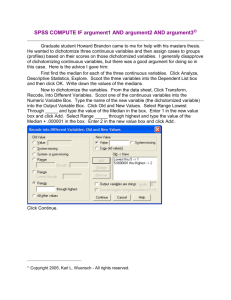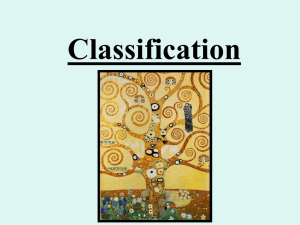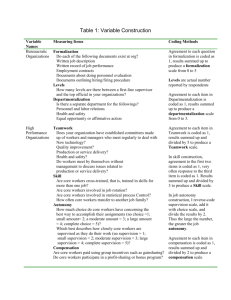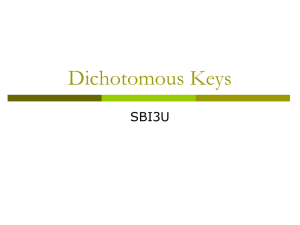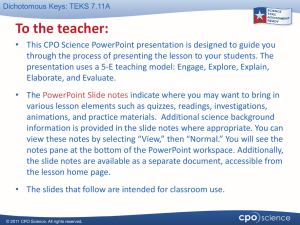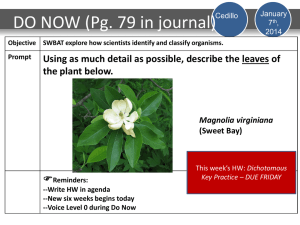Table 1 Variable Constructions
advertisement
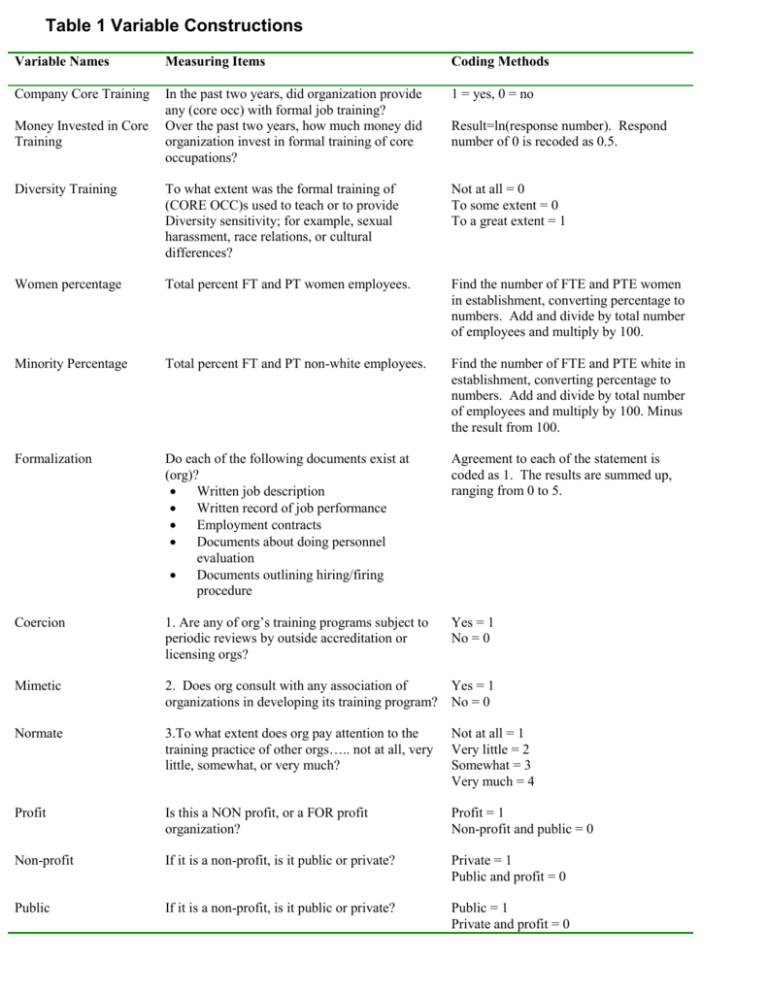
Table 1 Variable Constructions Variable Names Measuring Items Coding Methods Company Core Training In the past two years, did organization provide any (core occ) with formal job training? Over the past two years, how much money did organization invest in formal training of core occupations? 1 = yes, 0 = no Diversity Training To what extent was the formal training of (CORE OCC)s used to teach or to provide Diversity sensitivity; for example, sexual harassment, race relations, or cultural differences? Not at all = 0 To some extent = 0 To a great extent = 1 Women percentage Total percent FT and PT women employees. Find the number of FTE and PTE women in establishment, converting percentage to numbers. Add and divide by total number of employees and multiply by 100. Minority Percentage Total percent FT and PT non-white employees. Find the number of FTE and PTE white in establishment, converting percentage to numbers. Add and divide by total number of employees and multiply by 100. Minus the result from 100. Formalization Do each of the following documents exist at (org)? Written job description Written record of job performance Employment contracts Documents about doing personnel evaluation Documents outlining hiring/firing procedure Agreement to each of the statement is coded as 1. The results are summed up, ranging from 0 to 5. Coercion 1. Are any of org’s training programs subject to periodic reviews by outside accreditation or licensing orgs? Yes = 1 No = 0 Mimetic 2. Does org consult with any association of Yes = 1 organizations in developing its training program? No = 0 Normate 3.To what extent does org pay attention to the training practice of other orgs….. not at all, very little, somewhat, or very much? Not at all = 1 Very little = 2 Somewhat = 3 Very much = 4 Profit Is this a NON profit, or a FOR profit organization? Profit = 1 Non-profit and public = 0 Non-profit If it is a non-profit, is it public or private? Private = 1 Public and profit = 0 Public If it is a non-profit, is it public or private? Public = 1 Private and profit = 0 Money Invested in Core Training Result=ln(response number). Respond number of 0 is recoded as 0.5. Organization Size Total employment is number of full time and part time employees in the establishment on June 1, 1996. Full time means 35 or more hours per week. I take the natural logarithm of the total employees to indicate organization size. Organization Age Years from start of establishment operations until 1997. I take the natural logarithm of the years to indicate organization age. Independent Is org in any way part of a larger organization or is it completely independent? 1 = yes 0 = no Market Competition How much competition would you say there is in None = 1 your main market or service area . . . none, Very little = 2 very little, a moderate amount, or a great deal? A moderate amount = 3 A great deal = 4 Foreign market competition How much competition would you say there is in your main market or service area from foreign organizations . . . none, very little, a moderate amount, or a great deal? None = 1 Very little = 2 A moderate amount = 3 A great deal = 4 Organization industry What is the MAIN (product produced/service provided) there? Codes input according to the three-digit industry code from U.S. Census bureau. Agriculture: 10-60 Manufacturing: 100-392 Transportation: 400 – 472 Wholesale: 500-571 Finance: 700-760 Personal service: 761-791 Professional service: 800-899 Public administration: 900-932 (reference) Core occupation What are the job titles for the employees who are most directly involved with? Codes input according to 1980 occupational code by U.S, Census Bureau. Managers: 001 –037 Professional/technical: 043-235 Lower white collar: 243-389 Crafts: 503 – 699 Others: 703-889 (reference) Table 1 contin ues Table 2 Descriptive Statistics for the Variables Variable Names Mean Median Standard Deviation Data Type Dummy Variable = 1 Dichotomous Total Number of Cases 945 Core Occupational Training -- -- -- Money Invested in Core Training (natural log of the real monetary expense) 9.67 9.90 3.27 Continuous 217 --- Diversity Training -- -- -- Dichotomous 523 147 Organizational Women Percentage 46.41 50.00 27.70 Continuous 1002 --- Organizational minority Percentage 28.49 20 29.81 Continuous 1002 --- Formalization 3.24 4.00 1.69 Continuous 913 --- Coercion -- -- -- Dichotomous 187 581 Normative -- -- -- Dichotomous 325 586 Mimetic -- -- -- Dichotomous 141 603 Organization Size 4.51 4.38 2.41 Continuous 981 --- Organization Age 3.25 3.30 1.02 Continuous 1002 --- Organization market competition 3.28 4.00 0.93 Continuous 932 --- Organizational foreign market competition 1.77 1.00 0.99 Continuous 917 --- Profit -- -- -- Dichotomous 1002 710 Public -- -- -- Dichotomous 1002 201 Non-profit -- -- -- Dichotomous 1002 88 Independent -- -- -- Dichotomous 1001 316 560 Table 2 continues Variable Names Mean Median Standard Deviation Data Type Dummy Variable = 1 Dichotomous Total Number of Cases 1002 Agriculture -- -- -- Manufacturing -- -- -- Dichotomous 1002 178 Transportation -- -- -- Dichotomous 1002 65 Wholesale -- -- -- Dichotomous 1002 35 Retail -- -- -- Dichotomous 1002 149 Finance -- -- -- Dichotomous 1002 132 Personal service -- -- -- Dichotomous 1002 40 Professional service -- -- -- Dichotomous 1002 295 Public administration -- -- -- Dichotomous 1002 56 Managers -- -- -- Dichotomous 992 150 Professional/technical workers -- -- -- Dichotomous 992 283 Lower white collars -- -- -- Dichotomous 992 195 Crafts -- -- -- Dichotomous 992 78 Other -- -- -- Dichotomous 992 286 52 Table 3. Unstandardized Coefficients in Probit Selection Equation into Core Employee Job Training, OLS Model Predicting Training Investment, and Logistic Regression Predicting Diversity Training Independent Variables Probit Model Predicting Core Training Provision OLS Model Predicting Training Investment Logistic Regression Predicting Diversity Training Constant -1.811*** (.508) .003 (.002) -.003 (.002) -.025 (.436) -.428 (.389) .107 (.401) -.072 (.484) -.070 (.396) -.461 (.404) -1.017* (.482) -.443 (.361) --- 10.427 (5.695) -.026* (.011) -.003 (.009) -1.022 (1.556) .842 (1.498) -.193 (1.389) .051 (1.769) -.241 (1.408) .489 (1.586) 2.759 (2.433) .670 (1.398) --- -2.695* (1.341) .004 (.005) .015*** (.004) -.519 (1.025) -.491 (.647) -.918 (.690) .246 (.898) -.066 (.687) -.230 (.688) .023 (1.170) -.256 (.609) -- .047 (.196) .062 (.193) .157 (.191) .070 (.239) -- .255 (.781) .360 (.739) .042 (.786) -.204 (.939) -- .373 (.395) -.375 (.400) -.043 (.410) -.630 (.638) -- Women percentage Minority percentage Industry-agriculture Industry-manufacturing Industry-transportation Industry-whole sales Industry-retail Industry-finance Industry-personal service Industry-professional service Industry-public administration (reference group) Managers Professional/technical workers Low white collars Crafts Others (reference group) p <.05; ** p< .01; *** p<.001 Numbers in parentheses are standard errors Table 3 continues Independent Variables Probit Selection Model Predicting Core Training Provision 2 OLS Model Predicting Core Training Investment Logistic Regression Predicting Diversity Training Formalization .221*** (.043) .265 (.239) -.025 (.261) --- -.295 (.467) -.066 (1.032) .344 (.987) --- .495*** (.156) .712 (.599) .908 (.580) -- Coercive pressure --- Mimetic pressure --- Normative pressure --- Organization size -.164 (.425) .001 (.381) .645* (.282) -.020 (.069) -.012 (.134) .036 (.171) .131 (.138) -- Inverse Mills’ Ratio: Lambda (λ) .090** (.034) .009 (.066) -.029 (.080) .049 (.068) .278 (.138) --- .468 (.431) .328 (.404) .055 (.411) .573** (.215) .159 (.257) .219 (.309) -.100 (.276) --- Model χ2 (df) Number of establishments 36.25(22)* 533 -3.765 (2.689) 128.03(24)*** 205 -1.797 (2.309) 66.475(25)*** 453 Profit Public Non-profit (reference group) Organization age Market competition Foreign market competition Independent organization p <.05; ** p< .01; *** p<.001 Numbers in parentheses are standard errors Probit model is the selection model for the OLS regression of training investment and the Logistic regression of diversity training

